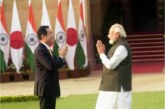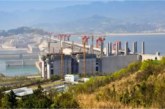By A.K. Awasthi, Deptt. of Botany. Brahmanand College, Kanpur 208004, India
The national river Ganga is a symbol of national unity and mother of Indian civilization. Ganga is not loved by Hindus alone but Non-Hindus of varied sects and religions also nurse a sentiment of religious fervor for it. Ganga symbolizes love of Hindustanis- a composite culture of India. All this is just because she is Ganga- a river par excellence. Ganga evokes a picture of holiness, reverence, peace, pleasure, joy and beauty; and reflects the symbol of something higher than any other river. Ganga provides physical and spiritual nourishment and is the life and soul of India.
According to Sri Ram Krishna, the renowned saint, “The Ganga River is believed to form a bridge between human and earth and the water flows as divinity”
The first mention of Ganga comes in Rigveda. Krishna in Geeta identifies himself as Ganga and Valmiki is perhaps the first saint to sentimentalize “Mother, you girdle of earth and thereby lend it grace and beauty.” Sankaracharya considers Ganga as the chief of the all Gods and Goddesses and as the redeemer of the fallen; Swami Vivekananda said “Geeta and Ganga constitute the essence of Hinduism; one its history and other its practice”. Jawaharlal Nehru considered Ganga’s story as one of Indian civilization and culture and remarked “she has been a symbol o India’s age long culture and civilization, changing ever flowing and yet ever the same Ganga.”
Ganga is the only river in the world that has a history rich in legends and myths, and also forms an integral part of the terrestrial, cultural and spiritual life of a nation. Ganga formed the lifeline of the ancient Aryan civilization about 5000 years ago providing irrigation, fertility of soil, source of water, communication and transport, scenic beauty and at the same time carrying the rubbish and human wastes, including half burnt bodies in her sweeping flows beyond pollution. Ganga was the glory to all successors, kingdoms and builders of new civilizations. Thus, Ganga becomes a symbol of fertility and a Mother Goddess that nursed, reared and sustained life. This invested symbolism has been held till today. Though unaware and ignorant of her utility, her spiritual power remains still intact.
Water is the elixir of life and basic or existence of ecosystem. Despite its abundance this vast resource has come to exist as a scarce commodity. Urbanization brings about changes in the ecological balance and breeds pollution. Pollutants’ input load into lentic and lotic waters has assumed alarming proportions. While aquatic systems have the ability to assimilate certain amounts of wastes and maintain normal functions, the continued pollutants spills tend to degrade the water quality.
A large number of industries in towns and cities along river banks are mainly responsible for pollution of India’s greatest river the Ganga. Disposal of untreated effluents and sewage wastes pollute the river water. The contamination of the Ganga is bipronged-organic and inorganic existing in the form of colloidal and dissolved matters, and biological organisms. River water is used for drinking purposes with minimum purification leading to many water-borne diseases like hepatitis in Kolkata, Kanpur etc., mainly due to polluted water. The pollution level of river in time and space can be measured by the BOD (Biological Oxygen Demand) of the river water. The purity of water is gauged in terms of dissolved oxygen used by fish and other aquatic plants.
It is nature’s own processes that maintain the delicate oxygen water equation normally. Water is essential for life as it supplies oxygen for survival. Natural waters are usually unpolluted and saturated with dissolved oxygen. As a universal solvent, water is used practically for every human enterprise from drinking, washing, bathing, and cooking, religious rituals to commercial aspects. While mechanism of nature helps to combat assault on river water quality, the influx of sewage, industrial wastes and agricultural washouts creates inorganic and organic substances of varied nature which fertilize water and promote growth of microorganisms. Sometimes they act as toxic substances detrimental to growth of flora and fauna, thus, destroying its regenerative capacity. Rivers today are no better than drains and sewers because of unplanned water management.
 Nature-man close interface has been part of ancient Indian heritage. A strong voice to express deep concern over environmental protection was that of late Prime Ministers Mrs. Indira Gandhi and Sri Rajiv Gandhi and they took up the initiative of cleaning of the entire river Ganga. A ten-member Central Ganga Authority was setup with Prime Minister Sri Rajiv Gandhi as its chairman.
Nature-man close interface has been part of ancient Indian heritage. A strong voice to express deep concern over environmental protection was that of late Prime Ministers Mrs. Indira Gandhi and Sri Rajiv Gandhi and they took up the initiative of cleaning of the entire river Ganga. A ten-member Central Ganga Authority was setup with Prime Minister Sri Rajiv Gandhi as its chairman.
In his inaugural speech on the occasion of launching the Ganga Action Plan of Varanasi on June 14, 1986, Rajiv Gndhi said: “The purity of the Ganga has never been in doubt. Yet we have allowed the pollution of this river which is the symbol o our spirituality. The felling of trees has caused severe floods and silts and mud now flow into the Ganga making the river shallow so that boats can not ply in it as they did before. Sewage and pollution from cities, industries and factories and dead animals are also thrown into the Ganga. From now on, we shall put a stop to all this. We shall see that the waters of the Ganga become clean once again”.
The Prime Minister Man Mohan Singh has worked out for the purpose of cleaning the national river Ganga. Collaboration between the consortium of seven IITs (IIT-Kanpur, Chennai, Mumbai, Delhi, Kharagpur, Guwahati and Roorkee) and Ministry of Environment and Forest, Government of India, has been worked out for the purpose of cleaning the national river Ganga. The two have signed an important memorandum of understanding (MOU) in this regard during Prime Minister Manmohan Singh’s visit to IIT Kanpur on July 3, 2010.
It will be worth mentioning here that the Central Government gave the Ganga status of National River and constituted the National Ganga River Basin Authority (NGRBA) on February 20, 2010. The Prime Minister Manmohan Singh is the chairman of the NGRBA. The Prime Minister asked the Ministry of Environment and Forest to involve IITs in this formidable challenge of cleaning the Ganga.
The NGRBA has members like Chief Ministers of states through which Ganga flows viz. Uttarakhand, Uttar Pradesh, Bihar, Jharkhand and West Bengal. The Union Ministers of environment and forests, finance, urban development, water resources, power, science and technology; deputy chairman, Planning Commission, are also its members.
Despite river protection, changing politics, involvement of hundreds of Non-Governmental organizations and religious institutions the problem of Ganga water has assumed greater dimension.
To save Ganga India needs another Bhagiratha to make the river metaphysical and free flowing, a Rajeev to restore its sanctity, a Sundar Lal Bahuguna to maintain its natural environment, and a Medha to sustain habitats in the lap of Ganga homeland not once in their life time but for all times to come.
Selflessness, purity and zeal for working for the river can alone save river Ganga. But these qualities exist in dreams- practically juxtaposed; Ganga still remains an endangered river.


